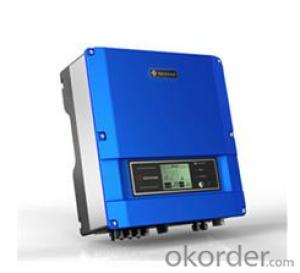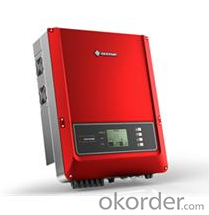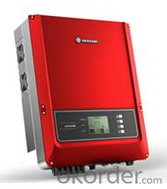On Grid Solar Inverter GW20K-DT PV1800
- Loading Port:
- Shanghai
- Payment Terms:
- TT OR LC
- Min Order Qty:
- 10 unit
- Supply Capability:
- 100 unit/month
OKorder Service Pledge
Quality Product, Order Online Tracking, Timely Delivery
OKorder Financial Service
Credit Rating, Credit Services, Credit Purchasing
You Might Also Like
GW20K-DT
GW20K-DT photovoltaic inverter is suitable for commercial and industrial roofs as well as small and medium-sized photovoltaic power systems. Intelligent heat dissipation design ensures slower temperature rise and more stable running conditions. The dual-lines MPPT extra-wide voltage range ensures that the system is with more flexible configuration.
| DC Input Data | Max.PV-generator power[W] | 20500 |
| Max.DC voltage[V] | 1000 | |
| MPPT voltage range[V] | 500~800 | |
| Turn on DC voltage[V] | 250 | |
Max.DC work current[A] | 22/22 | |
| Number of inputs/MPP trackers | 6/2 (can parallel) | |
| DC connector | SUNCLIX,MC IV (optional) | |
| Standby power consumption [W] | 10 | |
| AC Output Data | Nominal AC power[W] | 20000 |
| Max.AC power[W] | 20000 | |
| Max.output current[A] | 30 | |
| Nominal output voltage range | VDE-AR-N4105,VDE0126-1-1/A1,RD1699,G59/2,AS4777.2/.3 | |
| AC grid frequency | VDE-AR-N4105,VDE0126-1-1/A1,RD1699,G59/2,AS4777.2/.3 | |
| THDi | <1.5%< td=""> | |
| Power factor | 0.90 leading...0.90 lagging | |
| AC connection | 3W/N/PE,230/400V | |
| Efficiency | Max.efficiency | 98.2% |
| European efficiency | >97.5% | |
| MPPT adaptation efficiency | >99.5% | |
| Safty Equipment | Leakage current monitoring unit | Integrated |
| DC switch disconnector | Optional | |
| Islanding protection | AFD | |
| Grid monitoring | VDE-AR-N4105,VDE0126-1-1/A1,RD1699,G59/2,AS4777.2/.3 | |
| Normative Reference | EMC compliance | EN 61000-6-1 , EN61000-6-2, EN 61000-6-3, EN 61000-6-4 |
| Safety compliance | IEC 62109-1, AS3100 | |
| General Data | Dimensions(W*H*D) [mm] | 516*650*203 |
| Net weight [kg] | 39 | |
| Housing | For outdoor and indoor | |
| Mounting information | Wall mounting | |
| Operating temperature range | -20~60℃(up 45℃ derating) | |
| Relative humidity | 0 ~ 95% | |
| Site altitude[m] | 2000 | |
| IP proection class | IP65 | |
| Topology | Transformerless | |
| Cooling | Fan Cooling | |
| Noise level[dB] | <45< td=""> | |
| Display | 5"LCD | |
| Communication | USB2.0;RS485/Wi-Fi/ZigBee(optional) | |
| Standard warranty[years] | 5/10/15/20/25(optional) |
- Q: Can a solar inverter be connected to a battery storage system?
- Yes, a solar inverter can be connected to a battery storage system. This allows excess solar energy generated during the day to be stored in the batteries and used later when there is no sunlight, providing a reliable source of power.
- Q: Can a solar inverter be used with a solar-powered irrigation system?
- Yes, a solar inverter can be used with a solar-powered irrigation system. A solar inverter is responsible for converting the direct current (DC) produced by the solar panels into alternating current (AC), which is required to power various electrical devices. In the case of a solar-powered irrigation system, the solar inverter can convert the DC generated by the solar panels into AC to power the irrigation pump or other electrical components of the system. This ensures that the solar energy captured by the panels can be effectively utilized for irrigation purposes.
- Q: Can a solar inverter be used in a ground-mounted solar tracking system?
- Yes, a solar inverter can be used in a ground-mounted solar tracking system. The solar inverter is responsible for converting the direct current (DC) generated by the solar panels into alternating current (AC) that can be used to power electrical devices or be fed back into the grid. Whether the solar panels are fixed or mounted on a tracking system, the inverter's function remains the same.
- Q: How does a solar inverter handle voltage and frequency variations caused by grid faults?
- A solar inverter is designed to handle voltage and frequency variations caused by grid faults through a process known as grid support or anti-islanding function. When a grid fault occurs, such as a sudden drop in voltage or frequency, the solar inverter detects the disturbance and responds accordingly. To handle voltage variations, the solar inverter typically incorporates a voltage control mechanism. It monitors the grid voltage continuously and adjusts its own output voltage to match the grid voltage level. In the event of a voltage drop or spike caused by a grid fault, the inverter adjusts its output voltage accordingly to maintain a stable and safe operating condition. This helps protect both the solar system and the grid from potential damage. Similarly, the solar inverter also deals with frequency variations caused by grid faults. It constantly monitors the grid frequency and adjusts its own output frequency to match the grid frequency. If a grid fault results in a sudden change in frequency, the inverter responds by adjusting its own frequency accordingly. This ensures that the solar system remains synchronized with the grid and continues to supply power without disruptions. Additionally, solar inverters are equipped with anti-islanding protection, which means they are designed to quickly disconnect from the grid in the event of a grid fault. This is a safety measure to prevent the solar system from continuing to supply power to a faulty grid, which could pose a risk to utility workers trying to repair the fault. Overall, a solar inverter's ability to handle voltage and frequency variations caused by grid faults is crucial for the safe and efficient operation of a solar power system. By continuously monitoring the grid conditions and adjusting its output accordingly, the inverter ensures that the solar system remains in sync with the grid and provides stable and reliable power.
- Q: Are there any fire safety concerns associated with solar inverters?
- Solar inverters do pose some fire safety concerns. Although they are not typically a fire hazard themselves, there are a few potential risks to be aware of. Firstly, if the solar inverter is installed incorrectly, it can cause electrical problems that may lead to a fire. To prevent this, it is essential to hire a qualified and certified professional who can ensure that all electrical connections are secure and meet the necessary standards. Secondly, if the solar inverter is located in an area that experiences high temperatures or excessive heat, there is a risk of overheating. Inverters generate heat as they convert direct current (DC) from solar panels into alternating current (AC) for use in homes or businesses. If the inverter is not adequately ventilated or is exposed to extreme heat, it can overheat and potentially ignite a fire. Furthermore, if the inverter is faulty or damaged, it can increase the risk of fire. Regular maintenance and inspections of the solar inverter can help identify any potential issues and ensure its safe operation. To address these fire safety concerns, it is crucial to adhere to proper installation guidelines, regularly inspect and maintain the inverter, and ensure it is in a well-ventilated location away from sources of excessive heat. It is also advisable to have a fire extinguisher nearby and establish a fire safety plan in case of emergencies.
- Q: What are the potential risks of overvoltage in a solar inverter?
- The potential risks of overvoltage in a solar inverter include damage to the inverter itself, as well as other connected electrical equipment. It can lead to overheating, arcing, and even electrical fires. Additionally, overvoltage can cause a significant decrease in the lifespan and efficiency of solar panels, reducing their overall performance. It is crucial to have proper protective measures in place, such as surge protectors and voltage regulators, to mitigate these risks.
- Q: What is the role of a solar inverter in a solar-powered telecommunications system?
- The role of a solar inverter in a solar-powered telecommunications system is to convert the direct current (DC) electricity generated by the solar panels into alternating current (AC) electricity that can be used to power the telecommunications equipment. It also regulates the voltage and frequency of the electricity to ensure a stable and reliable power supply for the system.
- Q: How does a solar inverter handle high temperatures?
- A solar inverter handles high temperatures by incorporating advanced thermal management systems such as heat sinks and fans to dissipate heat efficiently. This helps to protect the inverter's sensitive components and maintain optimal operating conditions, preventing any potential damage or performance degradation caused by excessive heat.
- Q: Can a solar inverter be used with energy storage systems?
- Yes, a solar inverter can be used with energy storage systems. In fact, it is a crucial component in connecting solar panels with energy storage batteries. The solar inverter converts the direct current (DC) electricity generated by the solar panels into alternating current (AC) electricity, which can be used to power appliances and charge the energy storage system. Additionally, the inverter also manages the flow of electricity between the solar panels, energy storage system, and the grid, ensuring efficient and reliable power supply.
- Q: How does a solar inverter handle voltage stability in the grid?
- A solar inverter manages voltage stability in the grid by regulating the voltage levels of the electricity generated from the solar panels. It ensures that the voltage produced by the solar panels matches the voltage required by the grid, thus maintaining a stable and consistent voltage throughout the system. Additionally, solar inverters may also have features like reactive power control and voltage regulation capabilities, which further contribute to maintaining voltage stability in the grid.
Send your message to us
On Grid Solar Inverter GW20K-DT PV1800
- Loading Port:
- Shanghai
- Payment Terms:
- TT OR LC
- Min Order Qty:
- 10 unit
- Supply Capability:
- 100 unit/month
OKorder Service Pledge
Quality Product, Order Online Tracking, Timely Delivery
OKorder Financial Service
Credit Rating, Credit Services, Credit Purchasing
Similar products
Hot products
Hot Searches
Related keywords
























